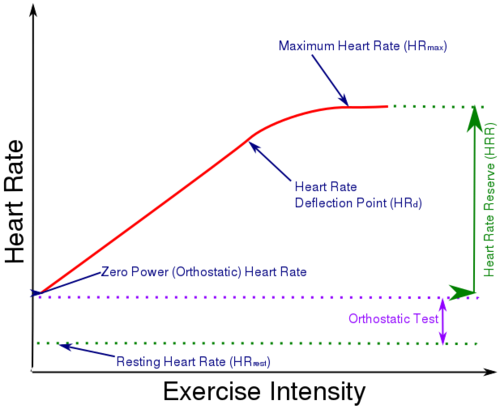Orthostatic Heart Rate Test

The Orthostatic Heart Rate Test is the difference between Resting Heart Rate taken when lying down and Heart Rate when standing (the Orthostatic Heart Rate.) The test measures how the heart responds to the added stress of standing up, which requires the heart to pump against gravity. The Orthostatic Heart Rate is sometimes considered a Symptom of Overtraining Syndrome.
Contents
1 Performing the Orthostatic Heart Rate Test
There are wide variations[1] in the details of how to perform this test, so the following is based on a research study that compared different approaches to determine the optimal solution[2].
- For monitoring Overtraining Syndrome, the test should be performed in the same way and under the same conditions each day.
- This test is normally performed on waking in the morning. If performed at other times, avoid things that change [Heart Rate]] such as exercise, stress or Caffeine before the test.
- Taking the Heart Rate reading should be done in such a way that it requires no effort on the part of the subject. A Heart Rate Monitor is ideal, and a Pulse Oximeter works well.
- The Resting Heart Rate should be taken after lying down for at least 5 minutes, preferably 10 minutes[2]. Lying down for longer is not required, but it is also not a problem.
- Stand up gently and remain still for 2 minutes before taking a second Heart Rate reading[2].
- The difference between the two readings is the Orthostatic Heart Rate.
2 What does the Orthostatic Heart Rate Test detect?
A high Orthostatic Heart Rate has been suggested as a symptom of Overtraining Syndrome, but it can also be caused by a viral infection, diabetes mellitus, as well as autoimmune and neurodegenerative disorders [3]. There seems to be little evidence to support the Orthostatic Heart Rate Test as a reliable method of predicting or detecting Overtraining Syndrome. However, this test is generally easy to perform and may be useful when considered as one possible indicator that can be factored in.
3 What does the number mean?
An Orthostatic Heart Rate rise of 30 BPM or more is a sign of Postural Orthostatic Tachycardia Syndrome (see below) and would indicate that a medical evaluation is appropriate. For detecting Overtraining Syndrome it is an increase in the size of the rise, based on an established baseline. That makes it tough to use this test for suspected Overtraining Syndrome unless there is a history of measurement that can be used for comparison. It has been suggested that an Orthostatic Heart Rate rise of 10-15 BPM is considered 'normal', and an increase of 5 BPM over baseline is indicative of Overtraining Syndrome.
4 Postural Orthostatic Tachycardia Syndrome
Postural Orthostatic Tachycardia Syndrome (POTS) is the Orthostatic Heart Rate is more than a 30 BPM rise, or the standing Heart Rate is greater than 120 BPM[4]. People with POTS have problems with lightheadedness or fainting when standing up.
5 Polar OwnOptimizer
Some Polar Heart Rate Monitors include a version of the Orthostatic Heart Rate called OwnOptimizer[5]. This test uses other Heart Rate parameters, such as Heart Rate Variability to indicate Overtraining Syndrome. There is some limited scientific evidence that the Polar test can detect intense training[6], but there is no evidence that is predicts or detects Overtraining Syndrome.
6 References
- ↑ Medscape Log In http://www.medscape.com/viewarticle/474822_2
- ↑ 2.0 2.1 2.2 Comparison of different methods of obtaining o... [Clin Nurs Res. 2000] - PubMed - NCBI http://www.ncbi.nlm.nih.gov/pubmed/11881701
- ↑ Orthostatic heart rate and blood pressure in ... [J Child Neurol. 2010] - PubMed - NCBI http://www.ncbi.nlm.nih.gov/pubmed/20197269
- ↑ Postural Tachycardia Syndrome Information Page: National Institute of Neurological Disorders and Stroke (NINDS) http://www.ninds.nih.gov/disorders/postural_tachycardia_syndrome/postural_tachycardia_syndrome.htm
- ↑ http://www.polarusa.com/us-en/support/OwnOptimizer?product_id=7881&category=tips
- ↑ http://www.polar.fi/en/about_polar/who_we_are/research/overtraining_test